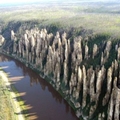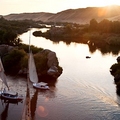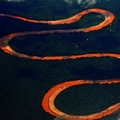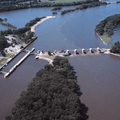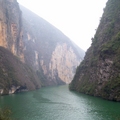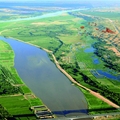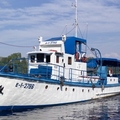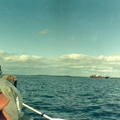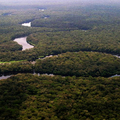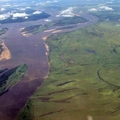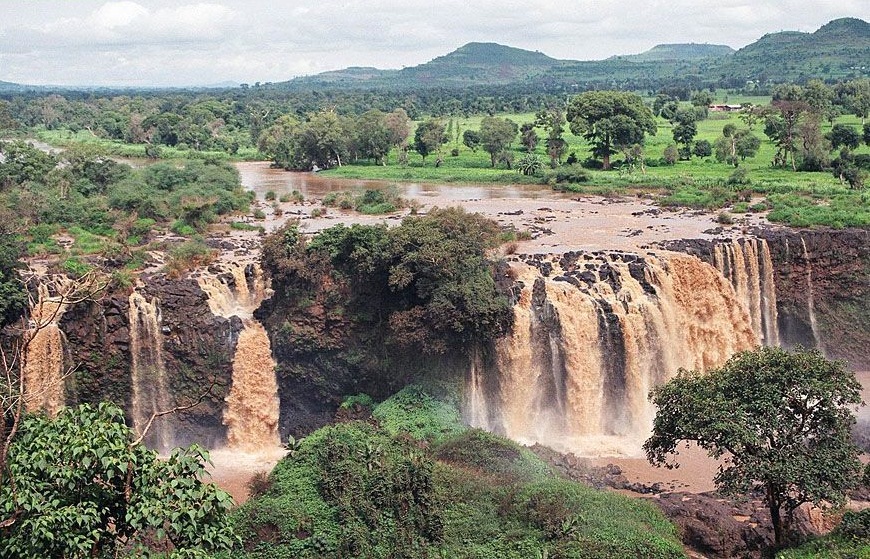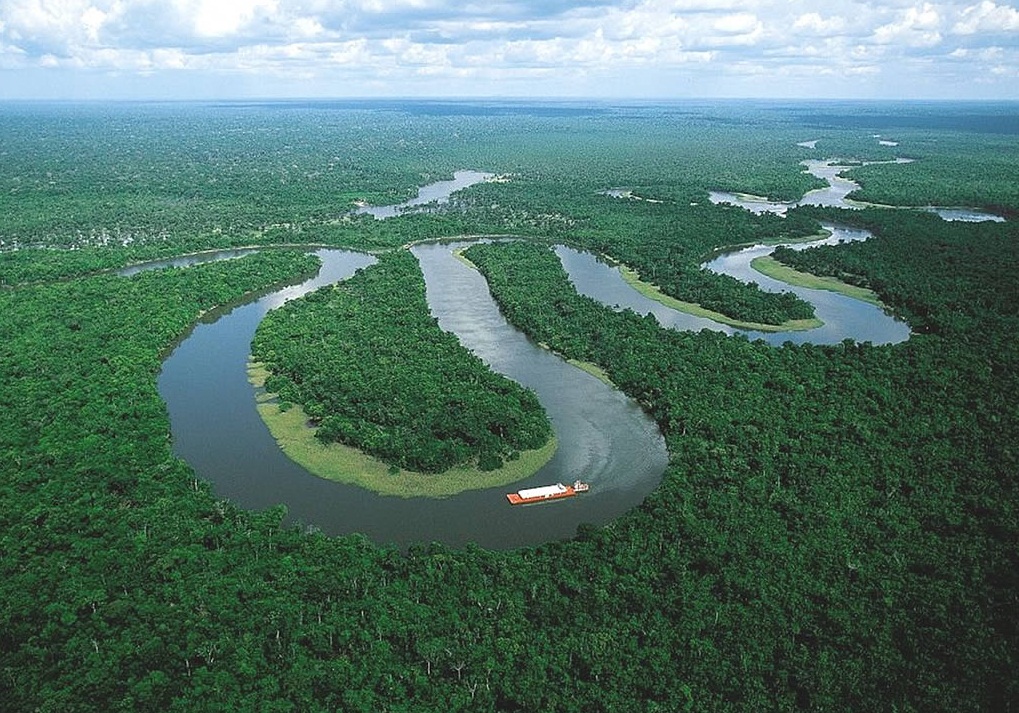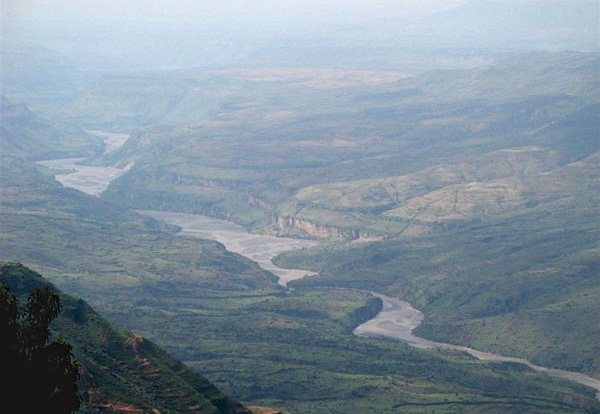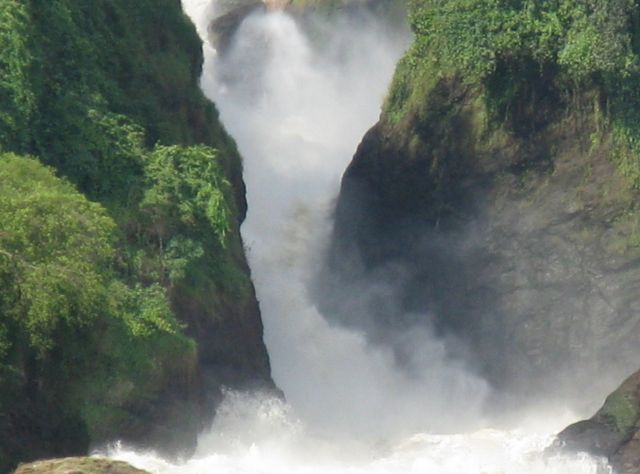Destinations / The Longest Rivers in the World / The Nile
The Nile
About the Nile
The Nile is a river in Africa, it is one of the greatest and the longest rivers in the world. The word "Nile" comes from the Greek name of the river "Neylos." The Greeks also called this river "Egiptos", hence the name "Egypt." The river originates in the East African highlands and flows into the Mediterranean, forming a delta. In the upper reaches the major tributaries are - Bahr el Ghazal and Achva, Sobat, Blue Nile and Atbara . Below the spring of the right tributary of the Atbara, the Nile flows through the semi-desert, with no inflows during the last 3000 km.
For a long time the Nile was considered the longest river on the Earth. Now definitively it was established that the longest river is the Amazon, which has not only the Ucayali and the Maranon, but the Apacheta river, opened in 1996 over the length of 7000 km. The peculiarities of the natural conditions of the basin, the nature of the hydrographic regime and the importance of Nile in the life of the people inhabiting its valley make the Nile , one of the most unique and remarkable rivers in the world. In the great lakes emerging in Africa, the Nile is the longest river in the world. The river paves its way through thousands of miles of deserts and marshes, then slowly twisting, accelerates by rapid and rapid flows.
The Blue Nile
In Khartoum, the Blue Nile flows from the east and the White Nile merges from the south. The Blue Nile flows out of the Tana Lake in the Ethiopian highlands (about 1800 meters above the sea level). From there the river flows southeast through the majestic waterfall Tissisat, and then a huge arc, whose length exceeds 644 km, cuts through the highlands of Ethiopia, before goes down to the hot plains of southern Sudan, located approximately 1372 meters below its source. Along the way, the river cuts through the plateau in the middle of a huge canyon, reaching in places a depth of more than 1.6 km and 24 km in width. And while the difficulties associated with going through the desert and overcome the rebellious gorge, prevented an accurate mapping of the Blue Nile expeditions up to Colonel RE Chizmena in the twenties and the thirties, there were Europeans from its origins hundreds of years before that. Pedro Páez became a pioneer, Portuguese monk, reached the waterfall Tissisat in 1618, but it was better known by the Scotsman James Bruce, "The Abyssinian", which reached the waterfall in 1770.
The White Nile
In contrast to the rapid flow of the Blue Nile, the White Nile, between Juba in the Southern Sudan and Khartoum is significantly slower. It is barely noticeable, mainly because of 1609 km. The way it goes down for no more than 73 m in Sedde, vast areas of seasonal wetlands, the river turns to the ever-changing network of canals, gasping for breath in a viscous mass of vegetation. From the time of the Roman emperor Nero, an expedition up the Nile, and until 1899, when, finally, there is a permanent paved channel, Sedd was almost an insurmountable obstacle for anyone trying to climb up the river.
The discovery of the great challenge of the world
By the middle of the XIX century the discovery of the origins of the White Nile was considered the greatest challenge the world's geographic. In 1858, John Hanning Speke, a member of the expedition RF Burton went to their independent travel and the first European to reach Lake Victoria in Central Africa, which he immediately announced the origins of the White Nile. There was a grand debate among the geographers about who is right - Speke and Burton, who claimed that the source of the Nile is the Tanganyika Lake. Several researchers, including the famous Scottish missionary doctor, David Lee tried to solve this issue. The final decision was not reached until Henry Morton Stanley during his brilliant move through Africa explored Lake Victoria and showed that it does not fall into any of the great river, which could be the Nile, and that the lake is the only Output - Ripon Falls, which begins itself in the White Nile. At the same time, he proved that the river at the northern tip of Lake Tanganyika, in fact, flows into the lake, but it does not follow from it. Speke, who, in truth, just guessed, was right. At the northern end of the river, the Nile delta is one of the most fertile places on the earth for thousands of years and did not lose its importance to the economy of Egypt. The construction of the Aswan High Dam , 965 km in Cairo, created a threat to the land of the delta, to terminate the valuable silt from upstream. On the other hand, the control of the water flow created conditions for the year-round irrigation, and now in some areas three harvests a year might be taken.
General characteristics
The length of the Nile is often ticked from the Victoria Lake, although in a fairly large river flow. Most remote point may be considered the source of the River Rukarara. The river part of the Kagera, which originates from over 2000 m heights in one of the mountains of East Africa south of the Equator flows to the Lake Victoria. The length of the Nile (from the Kagera) is about 6700 km (most commonly used figure of 6671 km), but from the Lake Victoria to the Mediterranean Sea is about 5600 km. The area of the basin, according to various sources is of 2,8-3,4 million km ² (fully or partially covers the territory of Rwanda, Kenya, Tanzania, Uganda, Ethiopia, Eritrea, Sudan and Egypt). The average consumption in Aswan is of 2 600 m ³ / sec, but in different year variations from 500 m ³ / s to 15 000m ³ / sec may appear.
The Origin of the Nile
The question of the origins of the Nile had run into European minds since Herodotus, who in his "History" presented to refute the view that the flood of the Nile comes from snowmelt in its upper reaches. According to the map of Herodotus the Nile merges with the Niger. In addition, the "father of history" brings the idea that the Nile hit the key out of the land between Siena (now Aswan) and the Elephantine, and half of them flows to the south and the other half - to the north. The sailors of Ptolemy II established that the cause of the spill is the season of rains in the Ethiopian highlands. In classical art the Nile was portrayed as a god with his head draped in a reference to its unknown origin. The work of Ptolemy claimed that the source of the River Nile is in the lunar mountains, and this opinion was followed by Pero da Kovilyanom in Ethiopia in modern times, followed by the Portuguese . At least two of them, Pero Paes (1564-1622) and Jeronimo Lobo (1593-1678), saw the source of the Blue Nile. However, their reports were published only in the XX century, and in 1790 a Scottish traveler James Bruce spoke in detail about the origins of the Blue Nile in his book, "Wandering in search of the source of the Nile." About the origin of the White Nile, 150 years ago there was no consensus. The ancient writers (such as Pliny the Elder) were taken for the upper reaches of the White Nile River Niger and so wrote that the Nile originates "on the mountain at the bottom of Mauritania." In modern times, the prevailing assumption of the existence is in the heart of Africa's great lakes, from which originate the Congo, the Niger and the Nile.
Along the Nile
The Victoria Nile
The plot of the source from the northern tip of the Lake Victoria to its confluence with the Lake Albert (Uganda, East Africa) is known as the Victoria Nile. Its length is about 420 km. Crossing the rocky ridge on the territory of Uganda, the river forms numerous rapids and waterfalls with a total fall of 670 m. The largest waterfall is of 40 meters height: Murchison. The river passes through the Lake Kyoga basin and flows into the Lake Albert on the border of Uganda and the Democratic Republic of Congo, which lies in a tectonic depression at 617 m.
The Albert Nile
The area between the Lake Albert and the mouth of the right tributary Achva is called the Albert Nile. The river has a flat flow pattern to its occurrence in Sudan through a narrow gorge Nimule, where the flow again becomes turbulent and full of rapids.
Bahr al-Jabal
Below the city of Juba, coming from within the highlands, the river is over 900 km crosses the vast flat basin, the wetland area Sedd ( called Bahr al-Jabal, "the river of the mountains"). Water logging is due to the fact that huge masses of seaweed and papyrus clutter the channel, the channel splits into several branches, the flow rate decreases, and most brought in from the mountains of water spilled on the surface evaporates, consumes aquatic vegetation. The islands of the aquatic vegetation, called seddami in high water come off the muddy ground and slowly float down the stream. Colliding and merging with each other, they often block the channel and interfere with navigation. The largest tributaries in this part of the course - Bahr el Ghazal ("River of gazelles") and the Sobat, where the waters flows down from the mountains, contain a large number of suspensions and have a characteristic dull yellow ,whitish color.
The White Nile
Sobat river below gets the name of the White Nile (Bahr al-Abyad), leaving behind a region of swamps, and then flows quietly in a broad valley in semi-arid areas to Khartoum where the Blue Nile merges with. Hence, to the Mediterranean Sea , the river is called Nile (El-Bahr).
The Blue Nile
The Blue Nile is much shorter than the White, but in the formation of the Nile below Khartoum regime, he plays a much bigger role. Blue Nile originates from the Abyssinian highlands, flowing from Lake Tana. From this plateau the Nile receives its last high-water flow - Atbara.
Aswan
Below the mouth of the last major Atbara tributary , at about 300 km from Khartoum, the Nubian desert begins. It makes a great bend of the Nile, cutting through the plateau, composed of hard sandstone, and crosses several thresholds . There are six thresholds between Khartoum and Aswan. The first one, closest to the mouth, is located near Aswan, just north of the Aswan Dam. Up until the 60s of the XX century ( before the construction on the territory of Egypt, the Aswan High Dam, 270 km from the Sudanese-Egyptian border), the thresholds represented a serious obstacle for continuous navigation. Permanent areas of navigation are used between Khartoum and Juba, Aswan and Cairo, Cairo and the mouth of the Nile. Now here is an artificial reservoir overflowed the Naser Lake, where Neil goes back to the north through the fertile valley width of 20-50 km, which was in the early Quaternary Gulf of the Mediterranean Sea.
The Nile Delta
At 20 km north of the Egyptian capital Cairo, the Nile delta starts growing with numerous branches, streams and lakes that stretch for 260 km along the Mediterranean coast from Alexandria to the Port Said. It was formed on the spot sea bay, gradually filling the sediments of the river . The area (24 thousand km ²) of the Nile delta is almost equal to the Crimean peninsula. "Delta", the mouth of the Nile was named by the Greek geographers, who compared it to a triangular shape with the letter of the Greek alphabet Δ, thus giving the name of all river deltas in the world. The precipitations, which make the Nile into the Mediterranean Sea, create an excellent nutritional base for the fish resources of the Eastern Mediterranean.
Importance to Egypt
The Nile is the only river in North Africa, which runs through the Sahara and brings its waters to the Mediterranean Sea as a source of life in an arid desert. The constant stream of the Nile exists due to the rainfalls in the more southern areas feeding its roots. Starting in the equatorial belt, the White Nile receives power from the year-round rainfall. In the upper level it is very high and fairly constant, as it is still regulated by lakes. However, within the Upper Nile basin, (Sedd) a large amount of water was lost to evaporation, and in the diet of the Nile below Khartoum more important is the Blue Nile, which has abundant water after a summer rain falling on the Abyssinian plateau. Nile downstream overflows, flooding the whole valley. Tributaries of the Nile, flowing down from the Abyssinian highlands, bring a large amount of silt deposited during the flood. This regular fertilizer plays an important role in the agriculture of Egypt. The water resources of the Nile in ancient times were used to irrigate and fertilize fields of natural fisheries, water supply and navigation. Especially important is the river to Egypt, where the coastal strip is of 10-15 km wide and where about 97% of the population lives.
The Nile- popular tourist route
The north of Aswan is a popular tourist route on the river Nile. Neil (in the ancient Egyptian language) was the source of life for the ancient Egyptian civilization since the Stone Age. It is in its valley where all the cities of Egypt are situated and it is still home to almost all its population. If you have the spirit of adventure and if you want to experience a wonderful adventure trip you can have a customary itinerary according to your needs and interests and have a cruise on the river enjoying wonderful views.
Others The Longest Rivers in the World .
Others from The Longest Rivers in the World
Everyone dreams to visit at least one of these places.
Those who live in modern cities with tall buildings tend to lose what Mother Nature has to offer.
They say "beauty is in the eye of the beholder," and there are probably many places that you consider to be most important in the world.
To our mind, rivers are very important and they offer splendid, natural views that Mother Nature offers.
Water is one of the most precious natural resources , we cannot live without it.
Globally, water supplies are rare: less than 1% of the world's water is good for consumption, and much of it, 2/3 of the Earth’s surface is covered by rivers and salt waters.
A river is formed from the union of several streams which naturally flow downhill , under the effect of gravity , which either flows into another stream or river ( its tributary ) or in a lake , a sea or an ocean .
For this reason we do not pretend that our list of places included are the most beautiful, but rather among the vast collection of the longest and the largest rivers in the world.
1 - Nile - 6600 km, the most beautiful areas of the basin downstream waterways are in Aswan.
2 - Amazon - 6480 km, the largest river basin in the world, cruises are up to Iquitos.
3 - Yang Tse Kiang - 6300 km downstream from the dam cruises.
4 - Mississippi - 6280 km, one in four Americans living around the pool's third largest river in the world, every city on its banks proposes at least one cruise.
5 - Yenissei - 5540 km, navigable by small portions, is the longest in Russia.
6 - Huang He (Yellow River) - 5464, with most cruises in China.
7 - Ob Irtchych - 5410 km, one of the 120 rivers that cross Russia.
8 - Congo - 4800 km, the second largest river basin in the world that flows, in sequence with Amazon, African adventure for the brave.
9 - Amur - 4500 km, navigable river, it crosses Russia and China.
10 - Lena - 4400 km, the most eastern of Russian rivers, crosses Siberia from the south to the north and it is one of the most fascinating deltas.
For the lovers of amazing sceneries, these rivers can be the perfect destinations and the cruises the most wonderful experiences.
Cruises have always aroused the curiosity of people even if not everyone can afford such a trip.
If the desire to live new sensations, schedule your vacation early next year and choose a destination that allows you to take a cruise on one of the longest rivers in the world.

